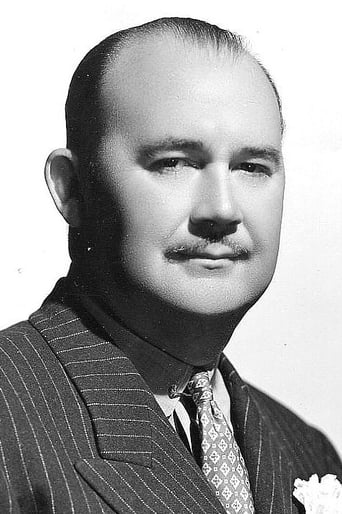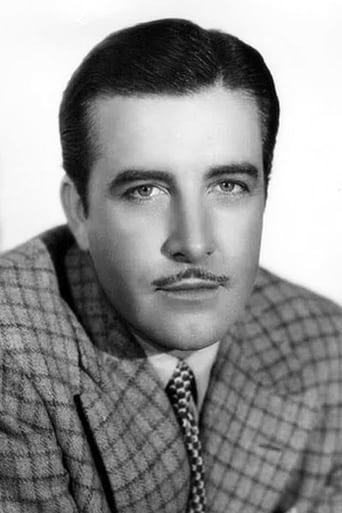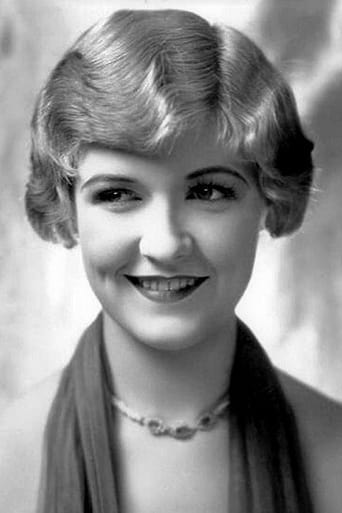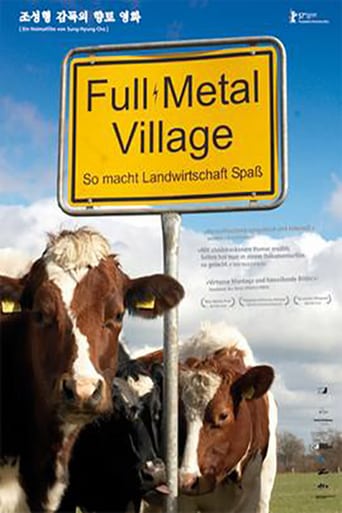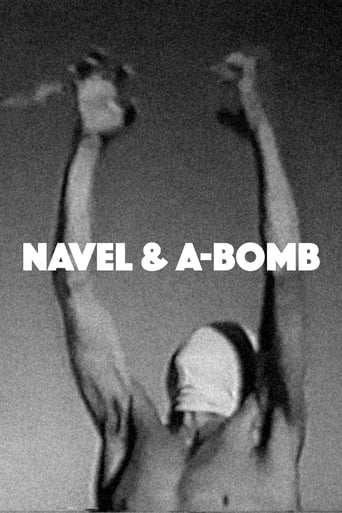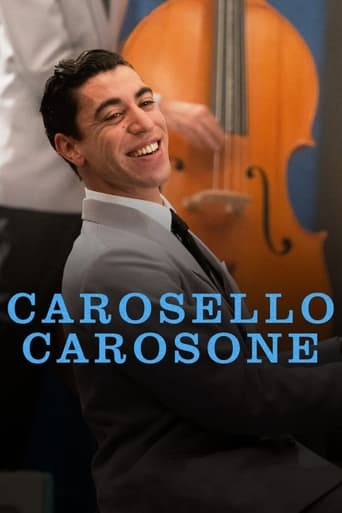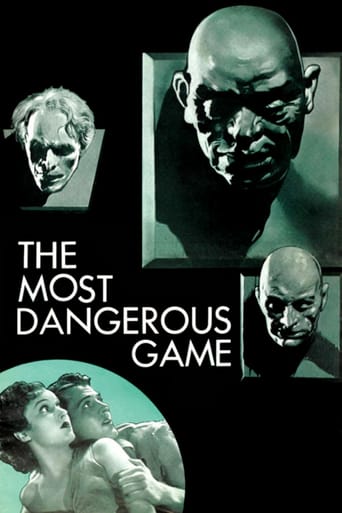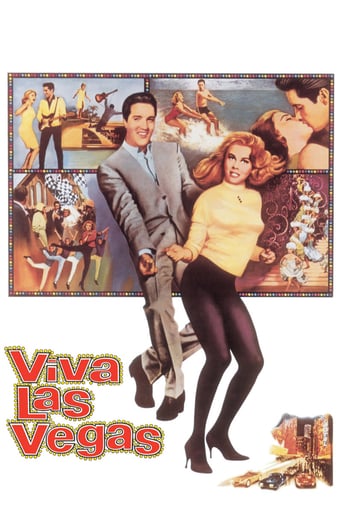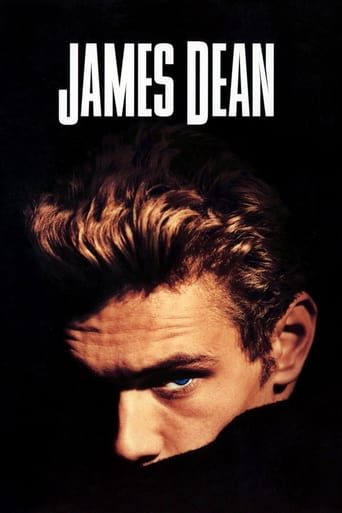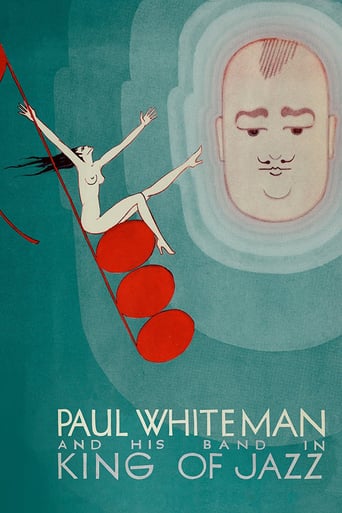
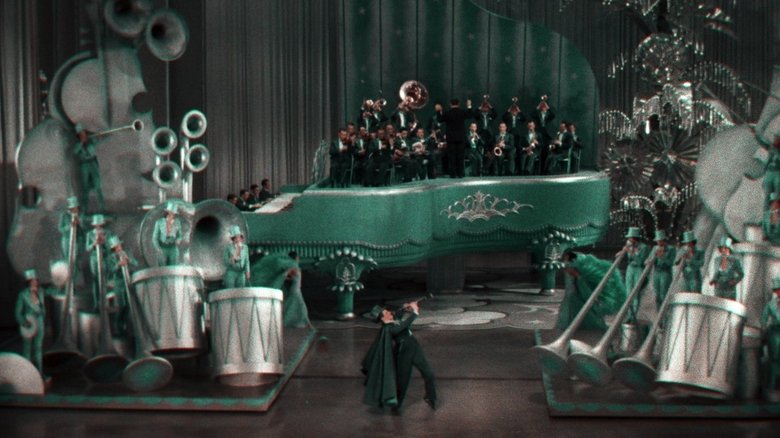
King of Jazz (1930)
Made during the early years of the movie musical, this exuberant revue was one of the most extravagant, eclectic, and technically ambitious Hollywood productions of its day. Starring the bandleader Paul Whiteman, then widely celebrated as the King of Jazz, the film drew from Broadway variety shows to present a spectacular array of sketches, performances by such acts as the Rhythm Boys (featuring a young Bing Crosby), and orchestral numbers—all lavishly staged by veteran theater director John Murray Anderson.
Watch Trailer
Cast
Similar titles
Reviews
Instead, you get a movie that's enjoyable enough, but leaves you feeling like it could have been much, much more.
Fun premise, good actors, bad writing. This film seemed to have potential at the beginning but it quickly devolves into a trite action film. Ultimately it's very boring.
This film is so real. It treats its characters with so much care and sensitivity.
The story, direction, characters, and writing/dialogue is akin to taking a tranquilizer shot to the neck, but everything else was so well done.
Not only is this extravagant, $2 million Musical/Comedy production from 1930 a real sweet treat of vintage movie-making - But - As an added bonus - You'll actually get to see the very first filmed sequence of "moonwalking" (55 years before late pop-icon, Michael Jackson popularized it).Yes. Indeed. "The King of Jazz" is pure "Depression-Era" escapism that's all glitz and glamour from start to finish.I was certainly quite surprised to find out that upon this picture's initial release (with its added novelty of being filmed in 2-tone Technicolor) - It actually bombed, big-time, at the box-office.
I just received the alleged restored version of king of jazz.Like the1983 v.h.s. version,the color wasn't restored to the way it looked on the Rohaur print and the way follow thru,vagabond king ,whoopee,before that was enhanced,Viennese night before was taken off you tube,and the fragment of Sally and on with the show and gold diggers of Broadway.This is the way king of jazz is suppose to look.The preservationist ,probably at the demand of universe gave it the same Multi color look,aka two color Cinecolor,look.Although some spot had three color blue tint or the whole scene was enhanced in 3 colors.Why? to sell it to the modern audience.A modern audience is suppose to see a classic film the way it was presented to theatrical audiences. limit palette,including magna color ,cine color and two color Technicolor. Even a film that might reflect the racism and antisemitism of the past ,to understand it.Unfortunately Herbert and Natalie Kalmus would welcome the change,since Technicolor was experimenting with 3 color cinema photography back in 1930 ,also.Those fragment look like it was shot in 1933 rather than 1930.The preservationist stripped the yellow orange tint out of the whole picture ,so it wouldn't look like an antique .It is and antique! except it.Before the opening of the king of jazz book the green on some of the spots were blue greened.The cartoons green sky ,was changed to blue green.Meet the boys was three colored ,except for the banjo player,the walls were tinted pure blue.The green part of the wall ,on the left,in Bridal vale was blue green from it's green look.Other than stripping the orange yellow tint in," meet the girls, wasn't touched.Ladies of the press was a cine colored as the VHS version,but,sharper.I met her in Monterrey all blue green tint convert.A kiss in the park blue green tint as usual,but all 35 m.m. print.Bing Crosby rhythm boy sequence ,blue green tint ,before lights turn on.Bluish green back ground behind Crosby's head.Spring time,subtle blue green.Happy feet ,left alone.A dash of spice -no change in color.Willy Hall, no change in the color.Song of the Dawn,introduction Cinecolor look ,the number,not touched.All noisy on the eastern- free from color and tint change.The sing along a bit three colored. I like to do things for you-hard to tell until near the end of the song Jeanie Lang 's dress tint stated to turn more green than earlier blue green,Raga muffin Romeo as cine colored as the VHS version. Oh forever more ,before the scene show up the darkness is pure blue,but when it lights up and the walls become deep light green tint.The fish store - hard to tell.The final- Cinecolor like old print ,but, sharper,the restored spots had some pure blue tint on the dark side,but Spanish dancer's faces is not washed out.The end of finale no blue tint.Rhapsody in blue introduction blue green tint graphics on wall.For d.v.d and Blu- ray version,rhapsody in blue dark green was lighted and some blue was added lightly blue green Roy Bargy green piano was changed to Cinecolor blue -green,contrary to the archive version that was in you tube.The recently discovered peep hole black out,color not touched.When I saw picture of the rohaur print, on the Vitaphone project news letter and Nitrate Ally news letter, I already knew that if it was restored that the color could be revision.I was right.No modern distributor these days like red and green history.They think if they can make a two color Technicolor features to look modern they can draw more audience or sale,not really.I tolerate the new color,but don't except it.On the bright side the Fish song is fully complete,without photo enhancement.The Ragamuffin Romeo is also compete.The finale has been completely restored.The singalong is complete ,but with photo enhancement The introductions have been put back on in photos enhancement.Leonard Maltin should of been ashamed not to express dissent against the revision of most of the two color.Good news the Cinecolor look out take ," We Have been lucky," Look whats it makes me and Horses neck is part of the out take menu and a cine color enhanced version of the reissue beginning title,so you can throw your VHS away and unofficial DVD version.It also contains a visual and audio partial version of the King of jazz book,for those who don't' have it.Micheal Feinstein discuses it.There are two Oswald rabbit Cartoons.I will explain it on a separate title.There are two shorts,"All American and I know everyone and everybody's Racket ,starring Walter Winchell.I too will discuss this on two separate titles on i.m.d.b. In spite of the color change,on many scenes it still worth watching and owning.A clear digital print.Complete numbers.a condense version of king of jazz book visual and audible.Cartoons.discussions.Good entertainment. 03/29/18
Songs by Milton Ager (music) and Jack Yellen (lyrics): "Music Has Charms" (played by Paul Whiteman and his Orchestra, sung by The Rhythm Boys—Bing Crosby, Harry Barris and Al Rinker); "My Bridal Veil" (Whiteman and Orchestra, Jeanette Loff, Stanley Smith, The Russell Markert Dancers, Jeanie Lang and The Hollywood Beauties); "A Bench In the Park" (Whiteman and Orchestra, Jeanette Loff, Stanley Smith, The Rhythm Boys—Crosby, Barris and Rinker, The Brox Sisters, The Russell Markert Dancers, The Sisters "G" and The Hollywood Beauties); "The Song of the Dawn" (John Boles); "Happy Feet" (Whiteman and Orchestra, Jeanie Lang, The Rhythm Boys—Crosby, Barris and Rinker, The Russell Markert Dancers, The Sisters "G", Al Norman, Charles Irwin); "I Like To Do Things For You" (Whiteman and Orchestra, Jeanie Lang, The Rhythm Boys—Crosby, Barris and Rinker). Songs by Mabel Wayne (music) and Billy Rose (lyrics): "It Happened In Monterey" (Jeanette Loff, John Boles, The Russell Markert Dancers, The Sisters "G", George Chiles, Johnny Fulton); "My Ragamuffin Romeo" (sung by George Chiles, Jeanie Lang; danced by Don Rose, Marion Statler). Song by Billy Moll and Harry Barris: "So the Blackbirds and the Bluebirds Got Together" (The Rhythm Boys —Crosby, Barris and Rinker). Music by George Gershwin: "Rhapsody In Blue" (the Whiteman Orchestra conducted by Paul Whiteman. Piano solo by George Gershwin with The Sisters "G", Jacques Cartier, Markert Dancers, Hollywood Beauties). Song by Harry Barris and James Cavanaugh: "Mississippi Mud" (The Rhythm Boys—Crosby, Barris and Rinker). Song by Buddy De Sylva and Robert Katcher: "When Day Is Done" (interpolated in the "Bench In the Park" sequence). Medleys played by Paul Whiteman and his Orchestra including "The Melting Pot of Jazz" production number* were orchestrated by Ferde Grofe from the following: "Caprice Viennoise" by Fritz Kreisler; "Nola" by Felix Arndt and James Burns; "Linger Awhile" by Harry Owens and Vincent Rose; "Aba Daba Honeymoon" by Arthur Fields and Walter Donovan; "Ballet Egyptien" by Alexandre Luigini; "A-Hunting We Will Go"; "Rule Britannia"; "D' Ye Ken John Peel?"; "Santa Lucia"; "Funiculi-Funicula"; "Comin' Through the Rye"; "Vienna Blood" by Johann Strauss; "Fair Killarney"; "The Irish Washer-woman"; "Ay-yi Ay-yi-yi"; "Song of the Volga Boatmen"; "Otchichornia"; a couple of marches by John Philip Sousa; a parody, "Has Anybody Seen Our Nelly?" Another parody, "Oh, How I'd Like To Own a Fish-store!"eventually leads us into a very funny, if-not-suitable-for-children jest as Slim Summerville explains to Otis Harlan his "Pretty Lucky So Far." The delightful "I'd Like To Do Things for You" has now been restored to its rightful place. Most enjoyable! Who said film critics don't fulfill a useful function? Jeanie Lang romances Paul Whiteman, then Grace Hayes and William Kent have a bash, while Nell O'Day joins the Tommy Atkins Sextette in some show-stopping acrobatics.Whether you like Barbershop Quartettes (and parodies of same) will determine your appreciation of "Has Anybody Seen Our Nellie?" I found it awfully funny (but then I'm with Sinclair Lewis. I like kicking the boot into dead dreary Main Streets like Shamokin, PA). Incidentally the threesome that join our spellbinding lead vocalist are Laura La Plante, Walter Brennan and William Kent. Stiff-as-a-bored (yes, that's the right spelling) John Boles rejoins us at this point for "Song of the Dawn." Thanks, John. Thanks a lot! (The sound recording, incidentally, is absolutely wonderful here, as indeed it is throughout the entire picture. But just listen to that full-throated roar of the male chorus, as our John urges the dawn into the skies)!And now we come to what the producer intended as the musical highlight of the whole film, "The Melting Pot of Jazz". This title, of course, merely provides an excuse for a vast nationalistic pot of production numbers from England, Ireland, Italy, Russia, Mexico, France and Spain, with cartloads of singers and hordes of dancing girls. The showgirls, I must admit, are super-attractive as always, though their costumes in this final number are not nearly as appealing as the filmy creations previously on show. All the same, it's enough to make Busby Berkeley gnash his teeth in envy, (particularly as Anderson has anticipated Busby by occasionally employing Buzz's trademark overhead shots).Incidentally, Anderson's style, apart from these few overhead shots, is strictly proscenium point-of-view. There are no reverse angles. None at all. This doesn't worry me. What does surprise me is a review on a certain web site that complains of a sound track that "pops and hisses". Not on the print under review. Admittedly, the color looks a little washed-out in places, though the two-strip Technicolor remains never less than appealingly novel. Its few blemishes like over- exposure won't worry a soul. The sound track, however, can only be rated one hundred per cent plus. Not a crackle, not a pop, not a hiss. Absolutely brilliant. Turn the volume right up — right, right up — and it's still crystal clear. My only complaint is that the sound track, like the movie, ends somewhat abruptly. Admittedly on an end title. But surely the curtain didn't just ring down at this point? Surely Whiteman provided a few minutes of run-out music to cheer the crowds on their way? (If he did, it ain't there no more. A pity).Summing up: All told, I don't quite echo Mordaunt Hall's miraculously rave review in The New York Times. Not every vignette rates ten out of ten in my book. Every musical production number, yes. Every "comic" interlude, no. Nonetheless, I still think Mordaunt's definitely on the right wave length: "This sparkling extravaganza reveals John Murray Anderson to be a magician of far greater powers than one imagined, even from his stage compositions. A Technicolor potpourri of songs, dancing and fun, it is a marvel of camera wizardry, joyous color schemes, charming costumes and seductive lighting effects." Right on!
They called Paul Whiteman the "King of Jazz" - only real enthusiasts knew he wasn't. He was big in every way and by 1922 was making a million a year and it was only natural that when movies found their voice Hollywood would beckon. That was Universal in 1929, Carl Laemmle was seeking a headliner band for a big budget musical. The "Whiteman Special" train bringing the band (including Bix Biederbecke who unfortunately didn't make it on film) from New York to Hollywood was highly publicized with public appearances at every stop but the story writers couldn't come up with a story so the band, who had sat around idle for months, temporarily went back to New York.Whiteman then suggested hiring John Murray Anderson, whose spectacular New York revues had made him Ziegfeld's closest rival and his futuristic and inventive influence made him the real star of the movie. There are so many tantalizing stories - Bing Crosby was all set to be the lead singer with the songs "It Happened in Monterey" and "Song of the Dawn" (a dazzler sang with a cowboy chorus) handed to him but he was involved in a drink driving incident in which he was sentenced to 60 days which was converted to a 40 day furlough but still saw the songs handed to John Boles who vocally was much better suited with his fruity tones. Years later in a documentary Crosby felt Boles carried the songs far better than he could have. Another story involved Jeannie Lang whose Helen Kane rendition of "Ragamuffin Romeo" and "I Like to Do Things For You" had preview critics raving but she had already been cut out of the soon to be released movie so editors had to quickly splice her back.The film begins with Bing Crosby singing "Music Has Charms" over the credits (one song that Crosby retained) and after an animated cartoon (the first in colour) showing how Whiteman became "King of Jazz" he steps out to introduce "his boys" - there's Joe Venuti and Eddie Lang playing a marvellous duet and a startling shadow looming down on banjoist Mike Pingitore as he strums "Linger Awhile". Then it's "the girls" turn and the marvellous Rockettes dressed in spangley peach and silver go into a precision formation dance and show why they became legends.Colour lends such a beauty to the "Bridal Veil" number with gorgeous displays of bridal gowns through the ages. Jeanette Loff (with the longest bridal train ever) looks as pretty as peaches and cream and sings very prettily too. Next are the fabulous Rhythm Boys who come out of the shadows of "Mississippi Mud" to sing a "super, super, special kind of production" (Harry Barris's words) of "When the Blue Birds and the Black Birds Get Together". Bing's sense of humour and comic timing is so spot on even though he was still only one of the Rhythm Boys. "A Bench in the Park" features Stanley Smith and Loff as a pair of lovers, joined in harmony by the Brox Sisters accompanied by the Rhythm Boys then "the girls" get together for a dance that was obviously the inspiration for "Pettin' in the Park". "Rhapsody in Blue" is just awesome, initially showing Jacques Cartier in a futuristic setting beating out rhythms on a huge drum. This sequence was supposed to have cost $500,000 with a huge centrepiece of a gigantic blue grand piano, the Paul Whiteman Orchestra inside, dancing girls on top of the keys, a kaleidoscopic effect of dazzling blue feathers and flowers. WOW!!Where do you start with "Happy Feet" - from a pair of dancing shoes, the Rhythm Boys giving it their unique interpretation (with plenty of piano banging) the Sisters G are shown singing with their heads reflected against a shiny silver surface below - very psychedelic, they then give an all too brief but spirited dance, then the Rockettes dance out of a New York skyline to do another precision tap, then Al "Rubberlegs" Norman takes centre stage to do another of his dazzling eccentric rubberlegs routine!! and lastly Paul Whiteman (or his double) has a go at a vigorous Charleston. "Ragamuffin Romeo" is another "eccentric" dance with Marion Stattler whose gymnastics have her being thrown around like a rag doll."The Melting Pot of Music" is almost too much with a succession of sounds and images, dances and countries (strangely no mention of the African American) which then blended into the finale. Interspersed throughout the film were comedy hot spots but unlike other reviews of the time, they were short, snappy and not labored and with the clear print you were able to recognise the stars (Laura La Plante etc). Another reviewer mentioned a preference to "Hollywood Revue of 1929" but I'm sorry for me there is no comparison. This was a true spectacle enhanced greatly by colour and showcasing legends of the music world, to say nothing of Paul Whiteman's ease in front of the camera, the other just relied on movie stars out of their comfort zones being able to bring in a curious public.Highly Recommended.
